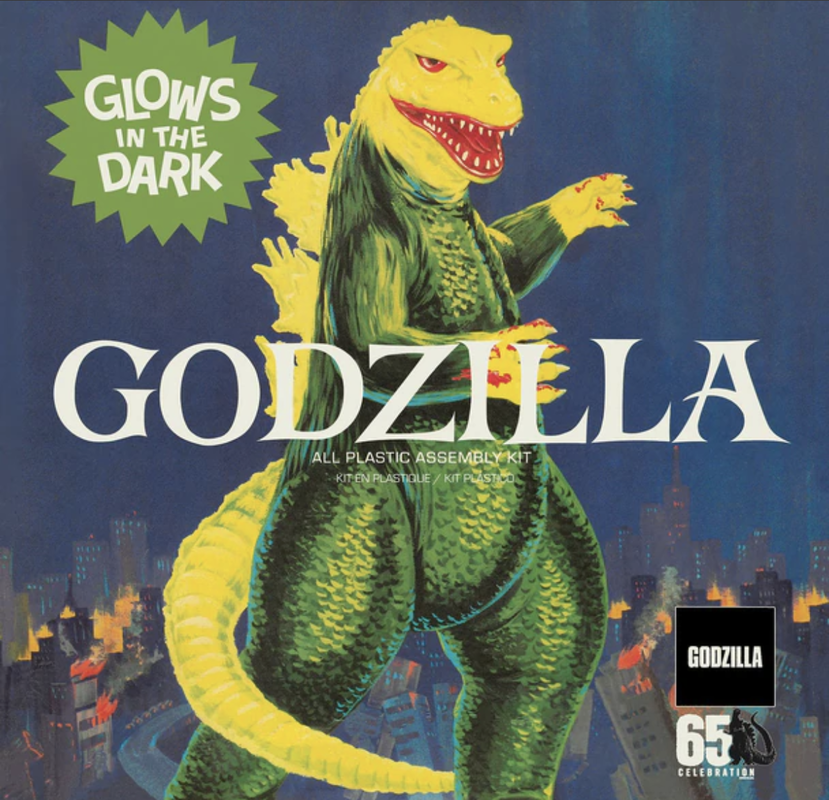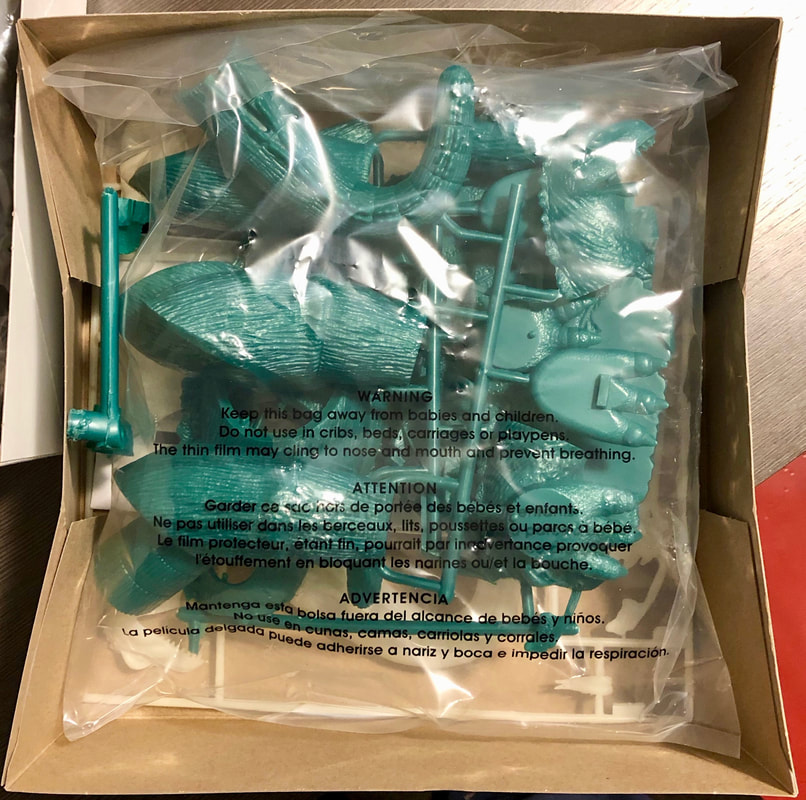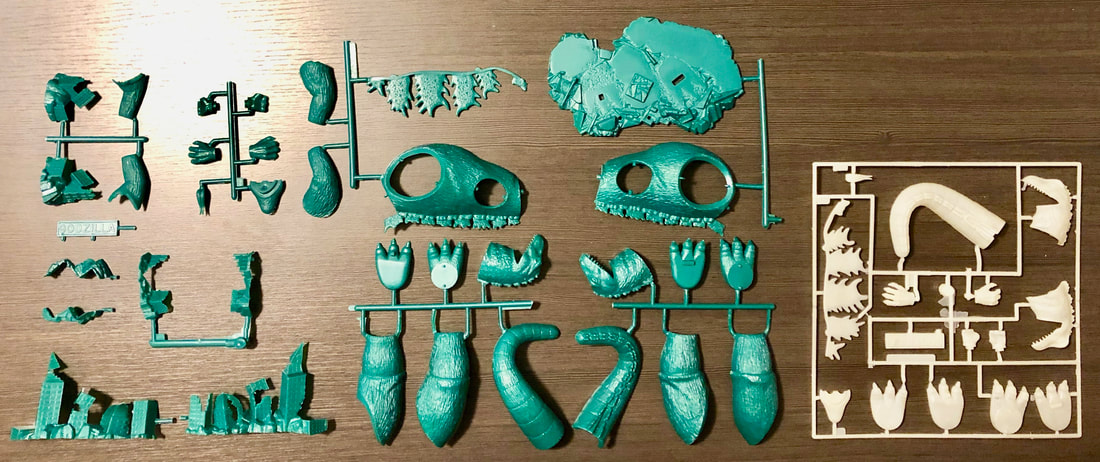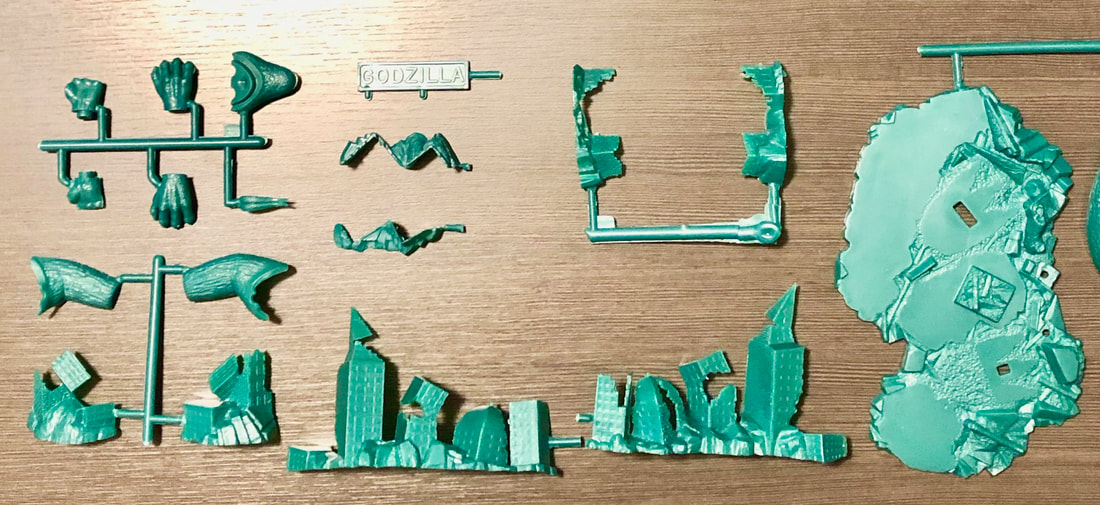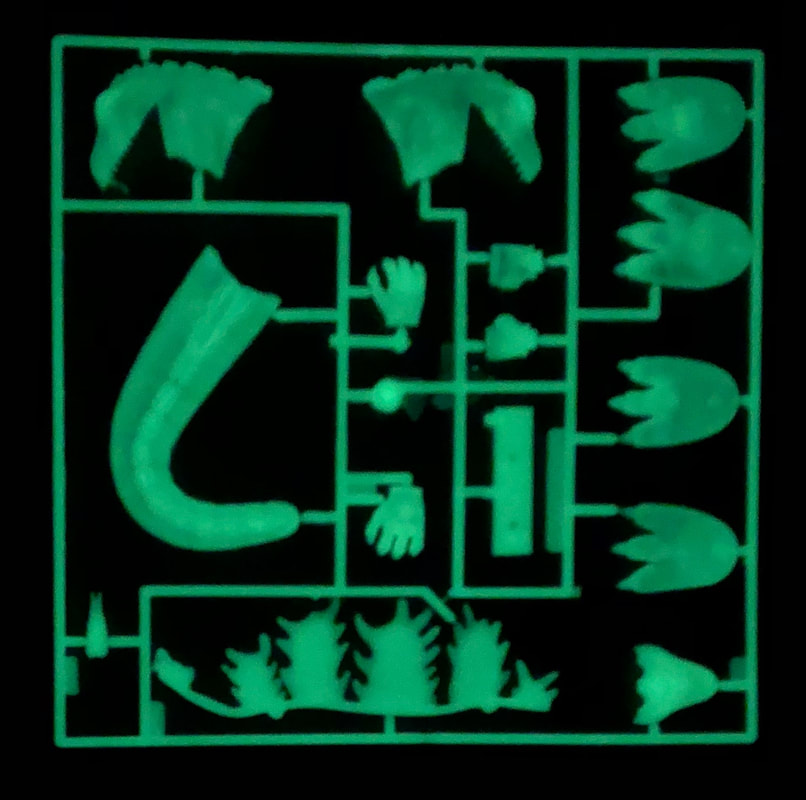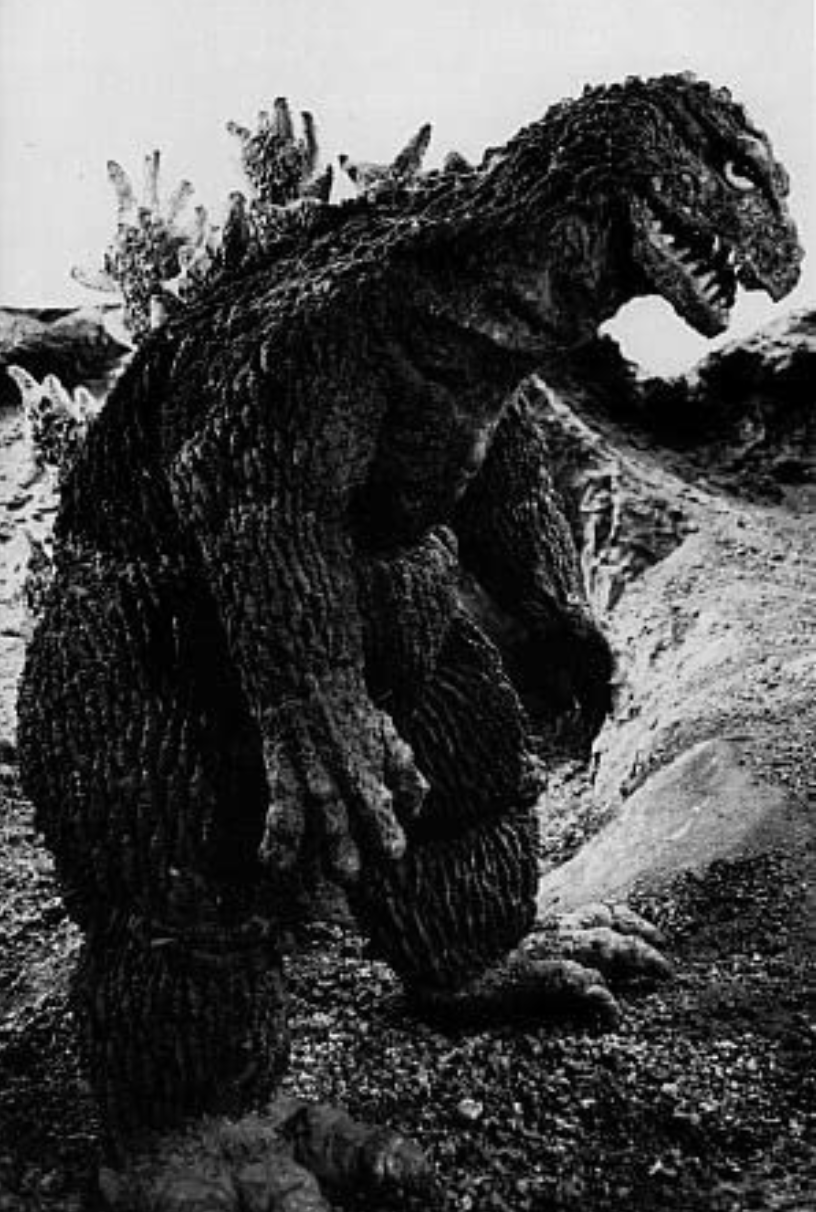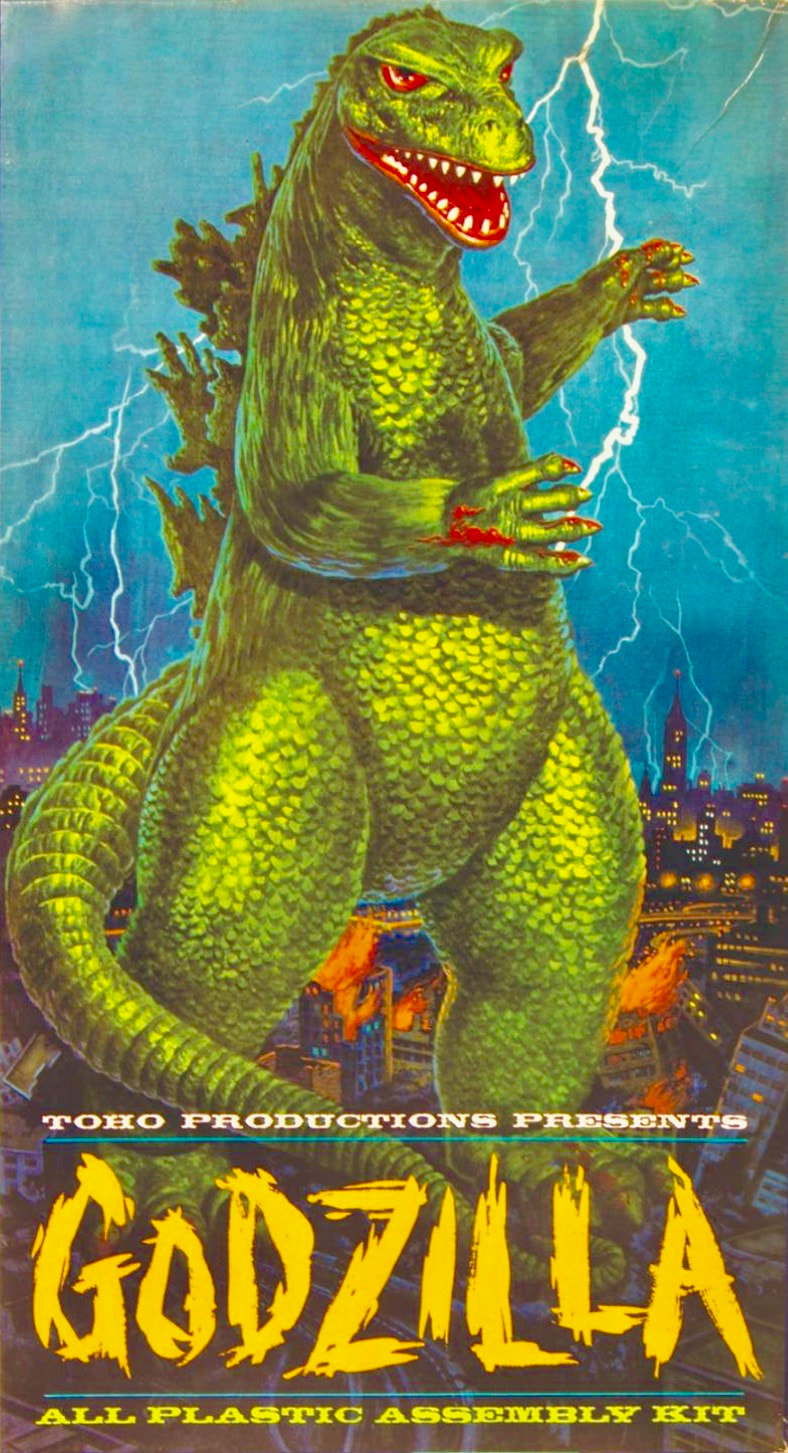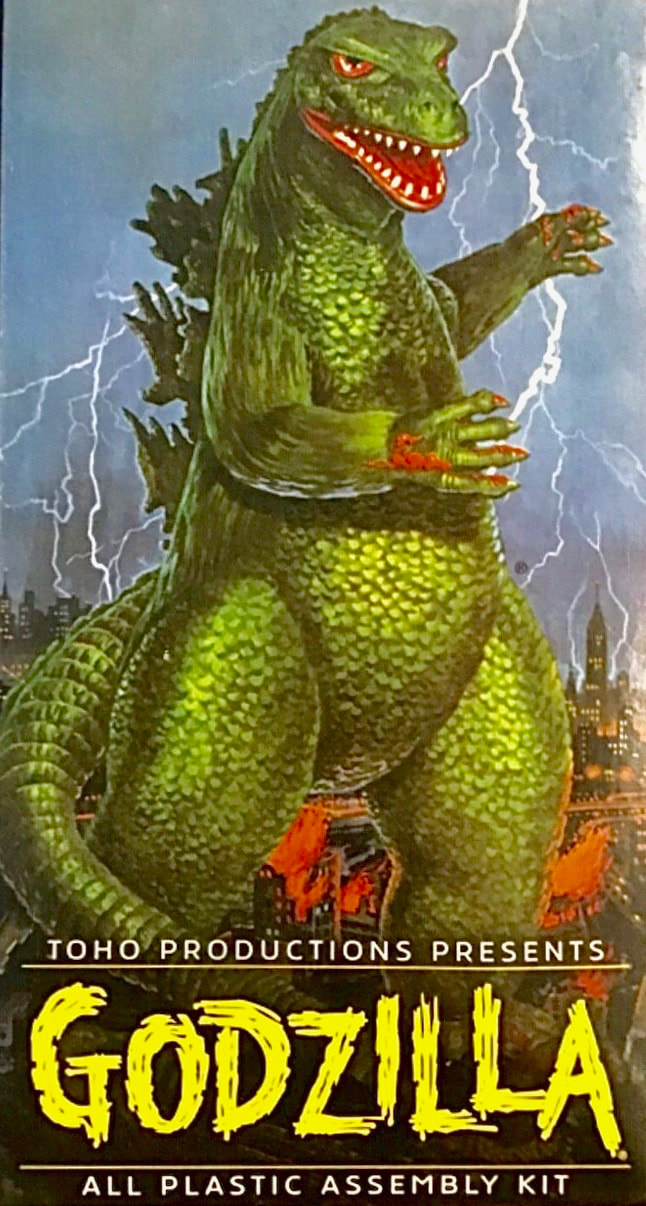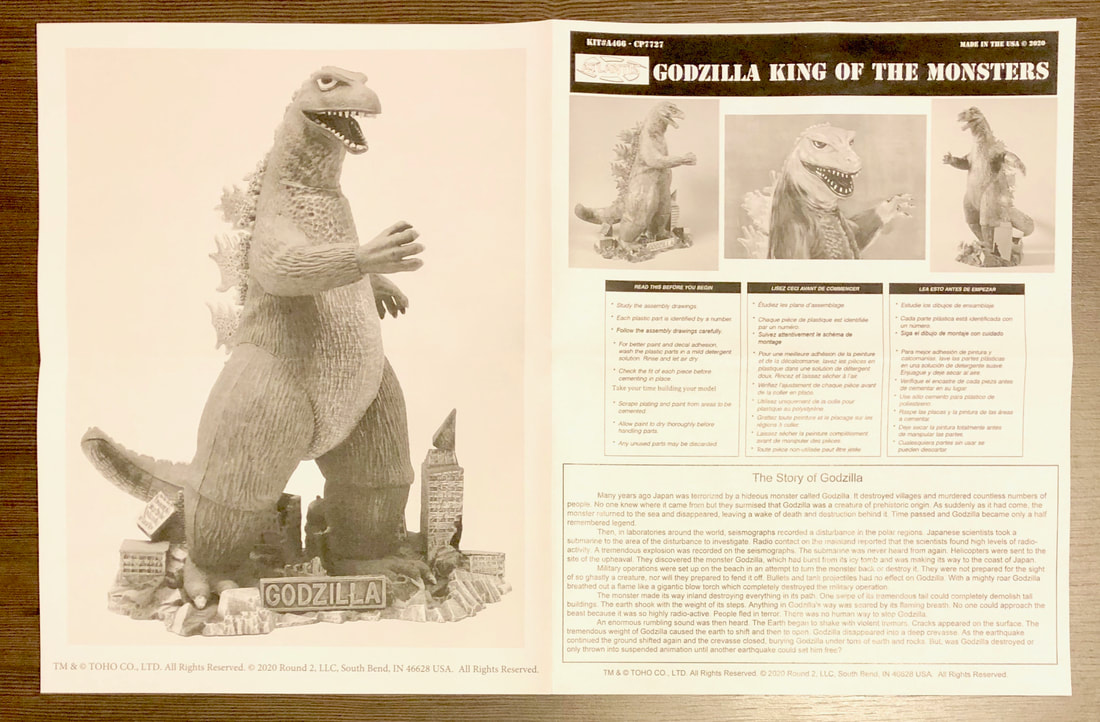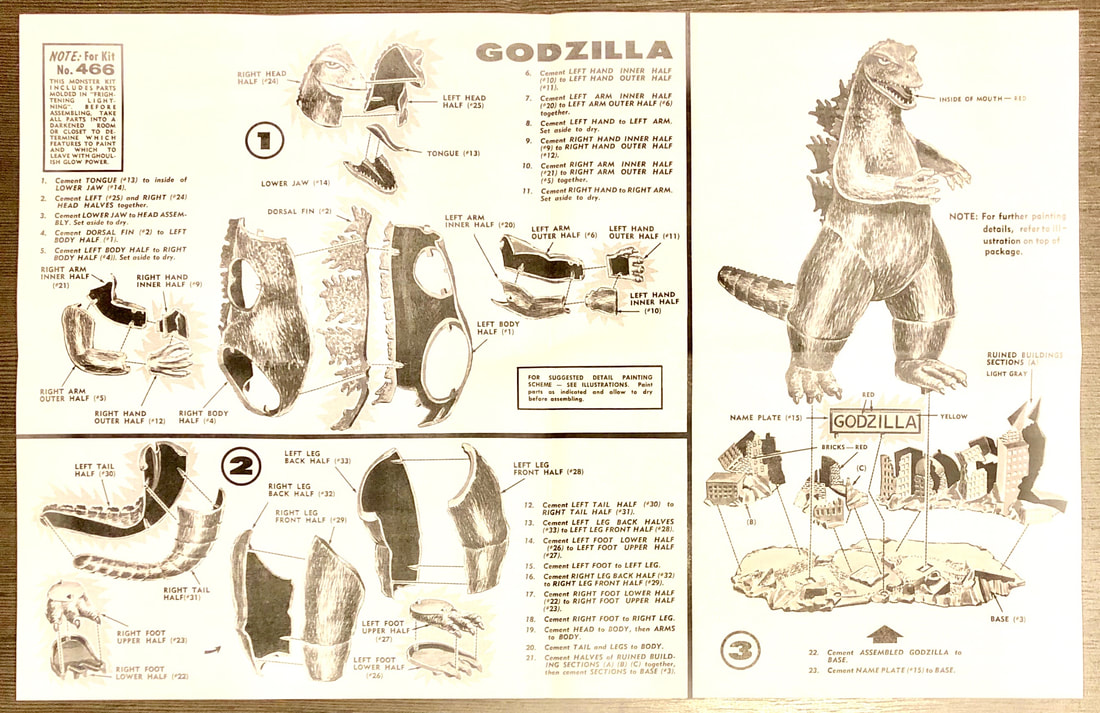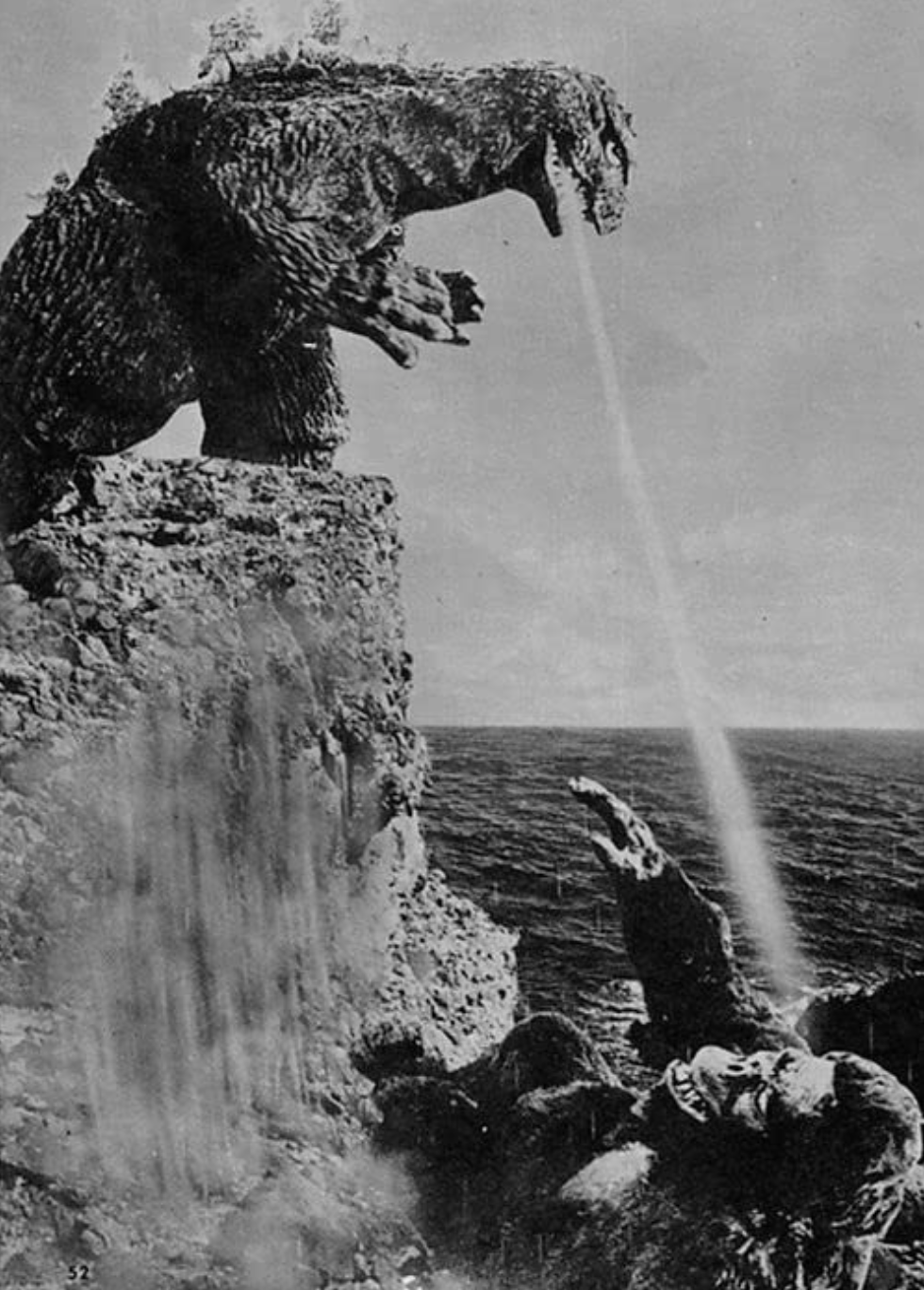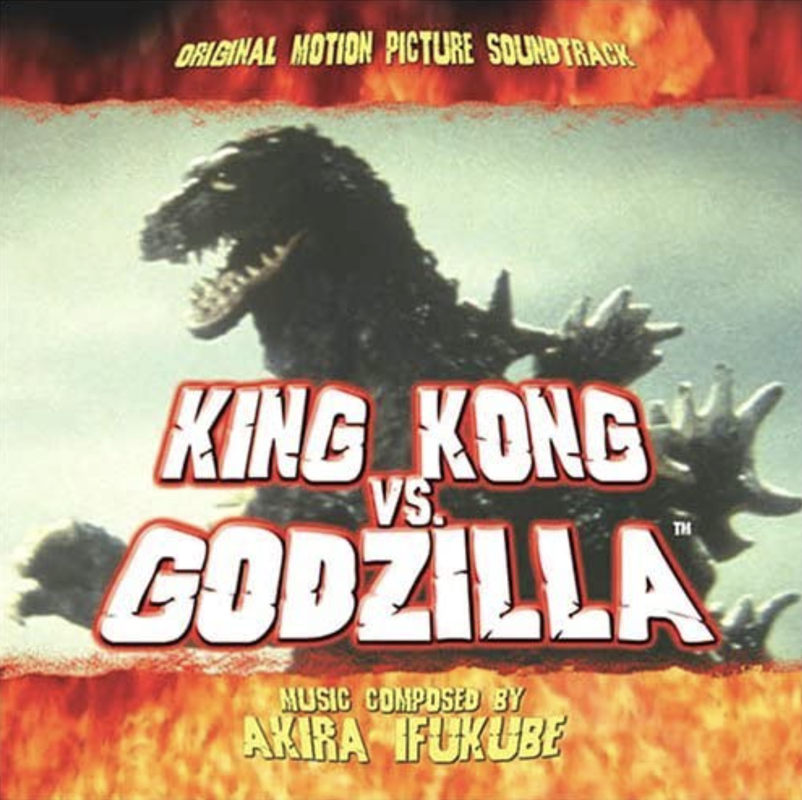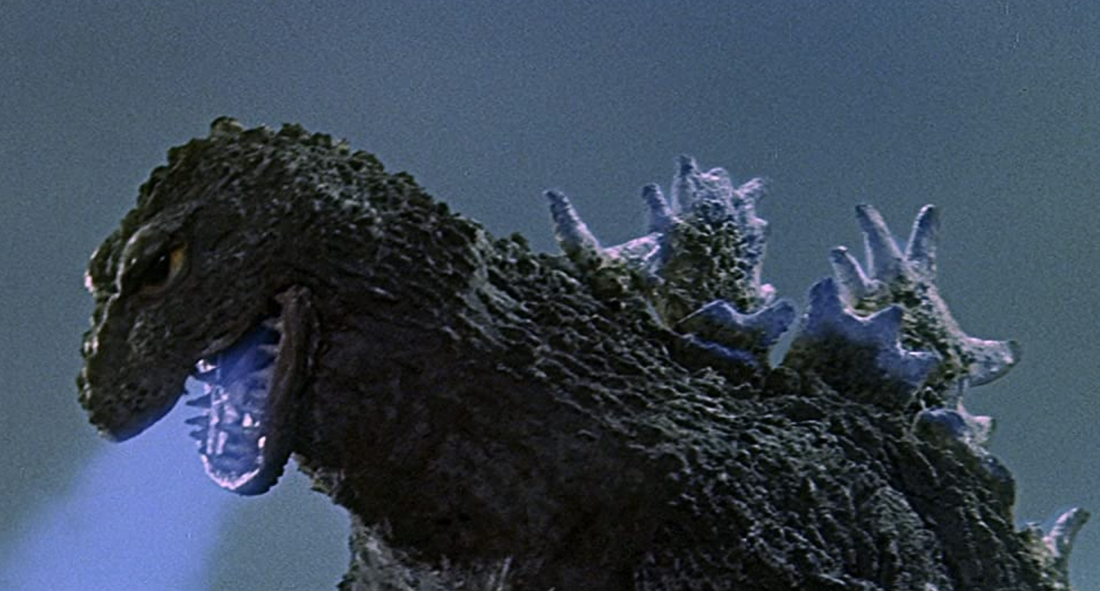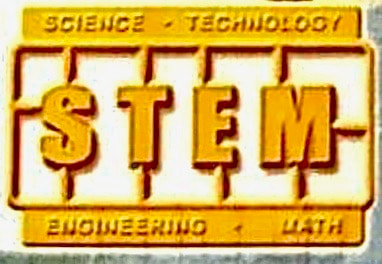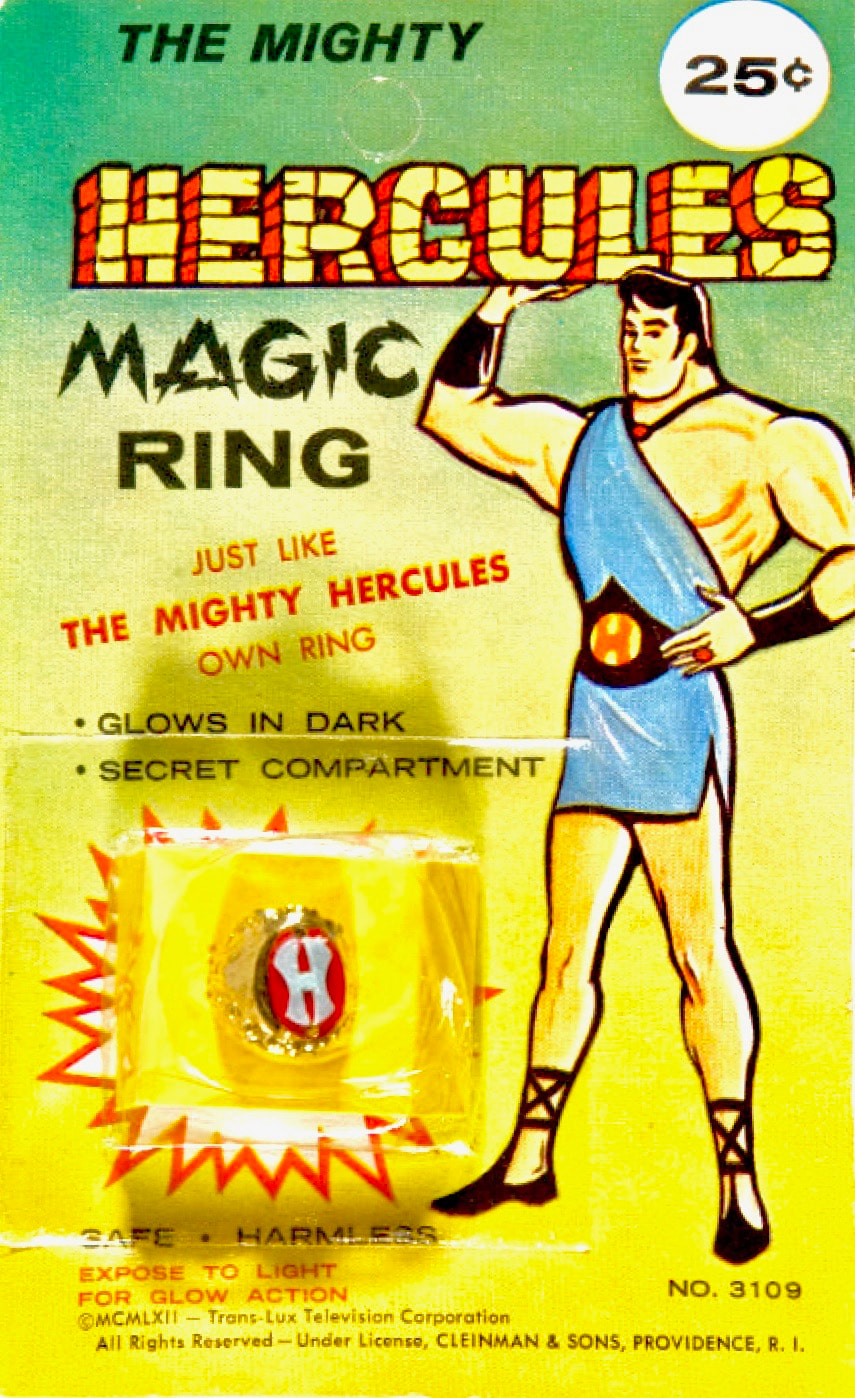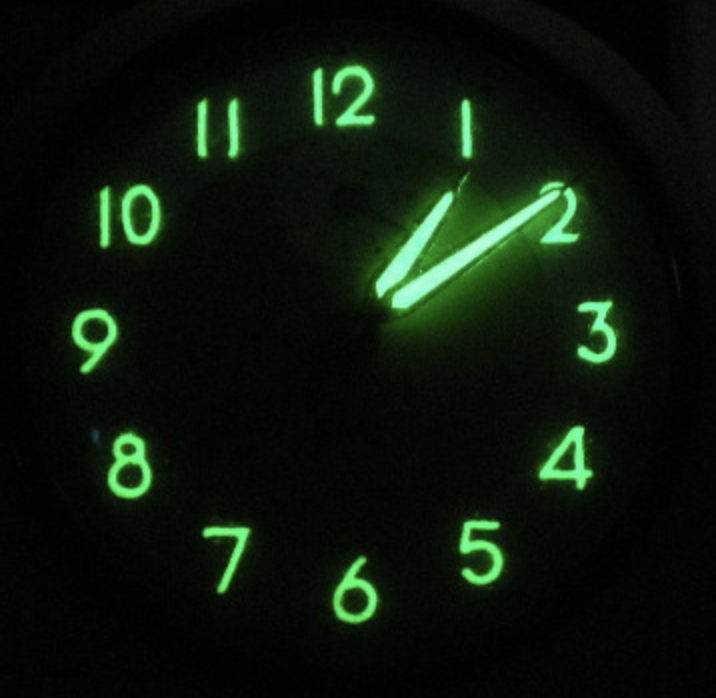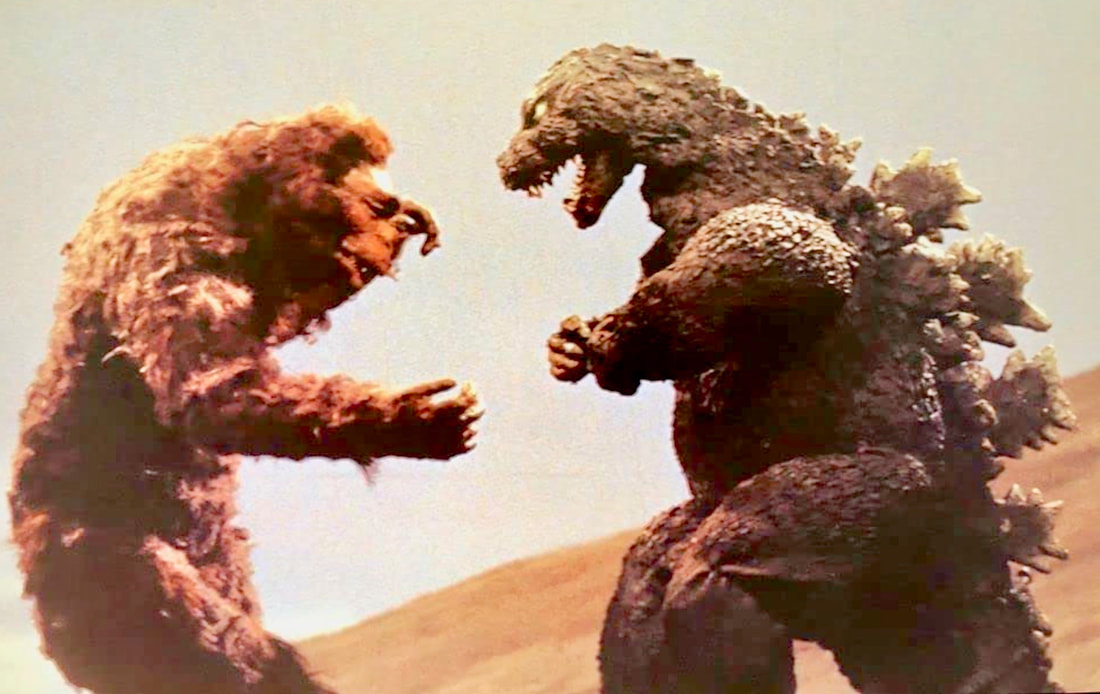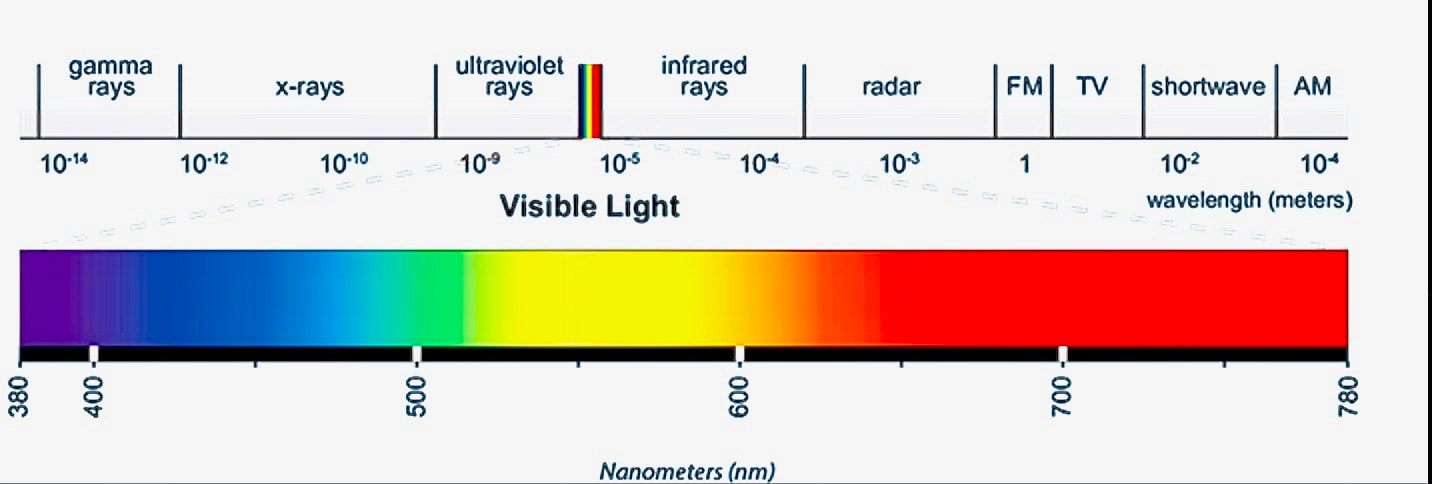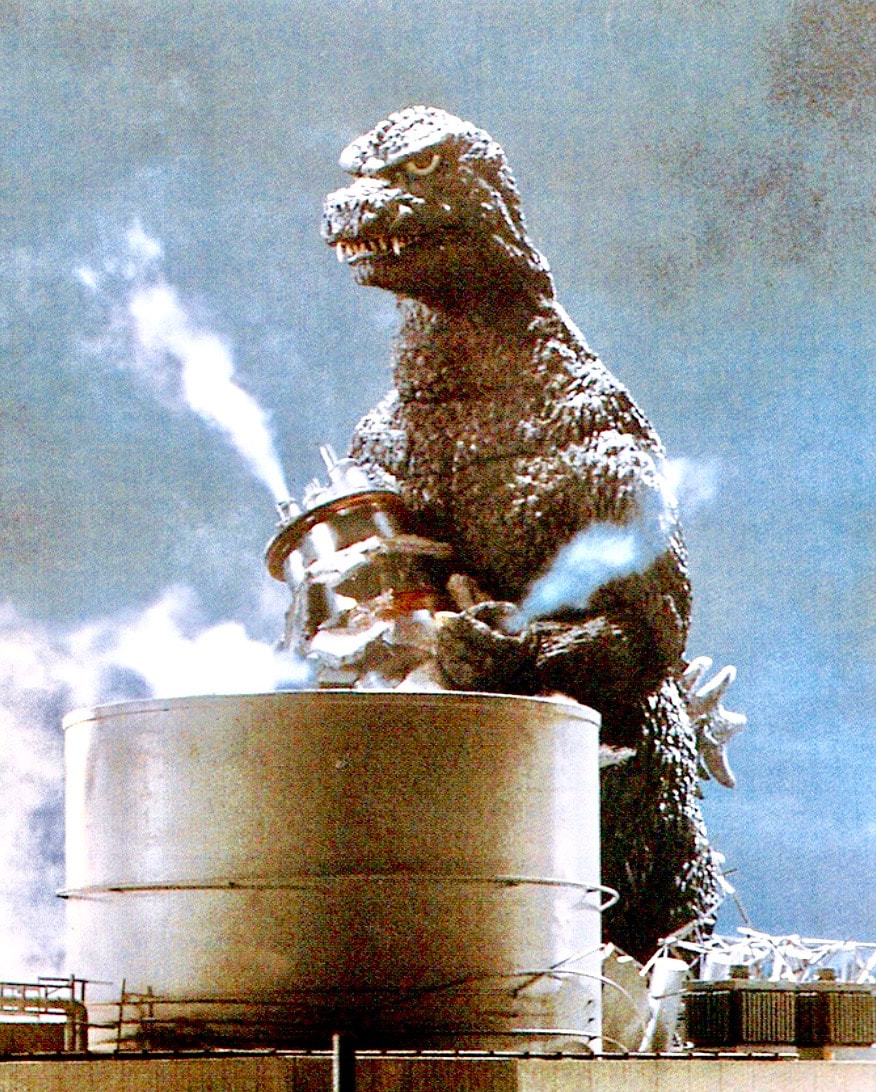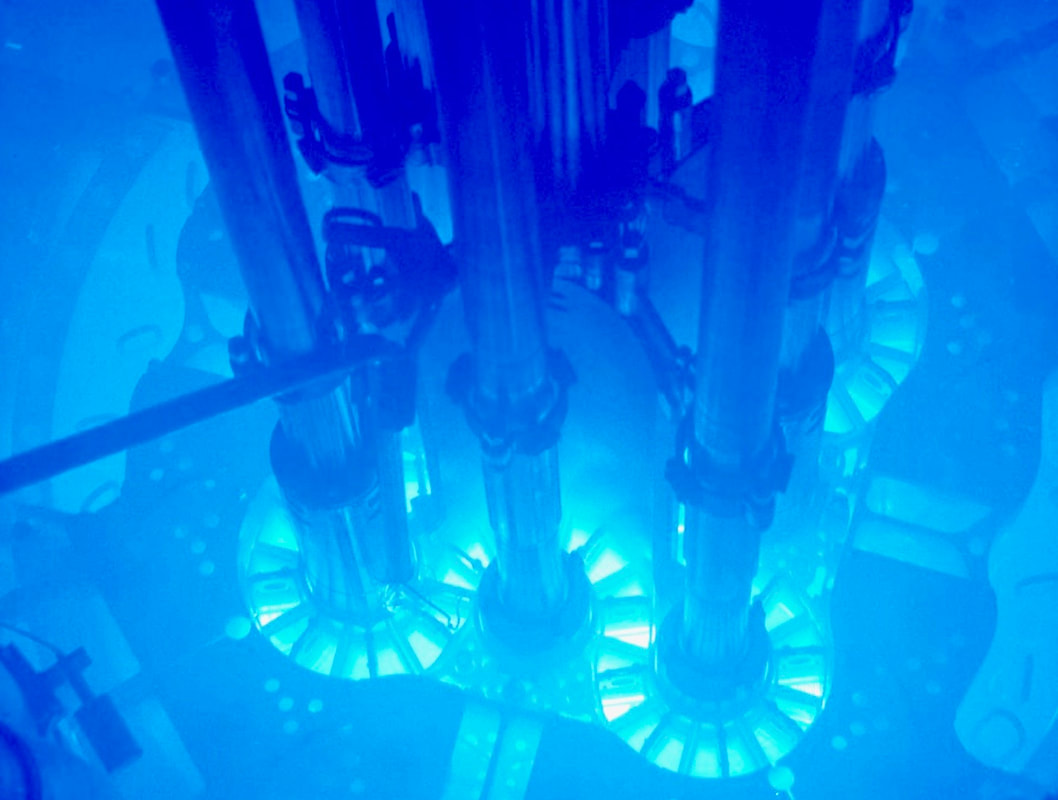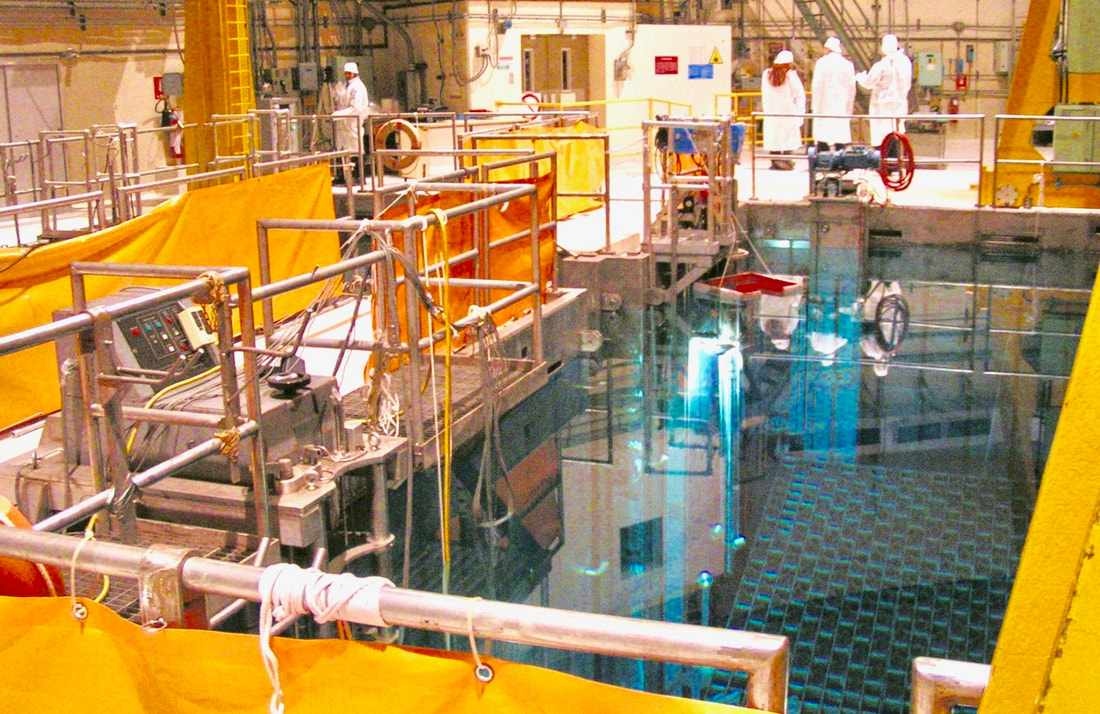By Bill Engar
ATLANTIS MODELS HAS RESURRECTED GODZILLA!
UPDATE: SPRING 2021--THE FIRST RUN OF ATLANTIS' GODZILLA HAS SOLD OUT! PREORDERS ARE NOW BEING TAKEN FOR A FINAL RUN BUT YOU'D BETTER ORDER SOON -- THESE WILL SELL OUT TOO!
SYNOPSIS: Don’t be wary of this particular sequel! Atlantis has given Godzilla fans and modelers alike a treat in the form of a perfectly executed reboot of the classic Aurora Godzilla model kit with extra “Glow Parts.” Buy, build, or collect with confidence.
NEW 17 FEB 2021: WE ADDED A BONUS SECTION ON THE SCIENCE OF GLOW-IN-THE-DARK FUN!
ATLANTIS MODELS HAS RESURRECTED GODZILLA!
UPDATE: SPRING 2021--THE FIRST RUN OF ATLANTIS' GODZILLA HAS SOLD OUT! PREORDERS ARE NOW BEING TAKEN FOR A FINAL RUN BUT YOU'D BETTER ORDER SOON -- THESE WILL SELL OUT TOO!
SYNOPSIS: Don’t be wary of this particular sequel! Atlantis has given Godzilla fans and modelers alike a treat in the form of a perfectly executed reboot of the classic Aurora Godzilla model kit with extra “Glow Parts.” Buy, build, or collect with confidence.
NEW 17 FEB 2021: WE ADDED A BONUS SECTION ON THE SCIENCE OF GLOW-IN-THE-DARK FUN!
In 2020, Atlantis began using square boxes as a nod to classic Aurora Company plastic model kits from the late 1960's and early 70's. This is the BIG square box just shy of ten inches on a side! And it's crammed full of classic Godzilla plastic!
|
The back of the box isn't just blank cardboard - you get a nice photo of a built-up model! Godzilla's appearance matches the classic movie monster as seen in King Kong vs Godzilla.
|
This side of the box provides kit specs: 8-1/2 inches tall, 48 parts. At 1/500-scale, this makes Godzilla about 350 feet tall!
This is what greets you when you first open the box.
|
It’s rare when my expectations are exceeded after opening a model kit, but they definitely were here. Atlantis Models has converted many of their latest kits to a square-box format, but this is the large, roughly 10X10X4-inch format that Aurora used back in 1970. One of Aurora’s strategies was to put their models in a bigger box than was needed to provide the illusion that modelers were getting more than was actually there. Atlantis certainly doesn't do this here. That extra-big Aurora-format box is needed to fit Godzilla. What else would you expect from the King of the Monsters?
Here is a shot of all the plastic that comes in the kit -- There is a bunch of it between the figure, base, and glow-parts, at right. That glow-sprue is 9.25" square by itself!
Aurora first tooled and released Godzilla in 1964. The latest Godzilla movie at that time was the third installment, King Kong vs Godzilla. In that Toho film, Godzilla sported a distinctly reptilian appearance to distinguish him from his simian rival. Godzilla had bigger eyes and alligator-like jaws faithfully depicted in the Aurora kit of 1964, which is now the Atlantis kit of 2020.
This is just the plastic for the figure alone - remember, Godzilla is a big guy!
The first Aurora incarnation of Godzilla came in a long box. Being one of the later entries in Aurora’s wildly successful line of monster kits, the company went all out to impress young modelers who already had built the likes of The Mummy, Phantom, Frankenstein’s Monster, The Creature, Wolfman, and Dracula. Godzilla was a big figure with a lot of plastic but he also came with a very detailed diorama base.
This view shows all the parts to the base in addition to the sprue containing Godzilla's hands, forked tongue, and lower jaw. Normally, you'd have to buy an aftermarket resin kit to get an enhanced base like this--but Aurora Models included it with Godzilla originally, and Atlantis faithfully represents it here.
Aurora’s monsters were huge sellers for the company from their 1962 debut, but by the late sixties, the sales slowed. In 1969, they revitalized the line by including glow-in-the-dark parts! Key features such as hands and heads were duplicated in a separate mold from the original kit masters and grouped on a new sprue with a handful of other key pieces from the kit that would make a creepy, glowing display. The new square boxes left no doubt that these latest kits had the special parts. Box art was updated by Aurora—for better or worse, some might say—with a depiction of the parts of the figure that would glow if built with those parts. Atlantis’ box reflects this 1970 version, the first time it has reappeared since its debut a half-century before. This model kit will probably become a collector’s item in its own right with a big, new “A” version of the Atlantis trademark and a special logo commemorating the 65th anniversary of the first Godzilla movie.
|
The photo of the glow-parts in the dark with NO enhancement whatsoever. Parts had been sitting out on a table about five feet away from room light for a few minutes, and the light was turned out for this photo. The plastic has a nice, bright glow! This sprue takes up the bottom of that 10X10-inch box.
|
In Atlantis’ Godzilla model kit, a new square glow-sprue with duplicates of the other parts fills the entire bottom of the box. Other parts are molded in a nice, reptilian-green plastic that might have a hint of metallic sheen similar to the original issue. Modelers who want to do little to no painting should be delighted by this choice of lizard-green plastic.
Godzilla's dorsal plates have an otherworldly appearance. Of course they're included in duplicate with the glow-parts.
It needs to be made clear that the 1964 kit with all its original parts is included. All the glow-parts are duplicates of pieces that are already in the box. So a standard, green Godzilla can be made with no painting if the modeler so chooses. I’ll probably build my Godzilla like the classic non-glow variety and the square sprue is cool enough on its own that I’ll hang it on my wall as-is. Or, I might just get another kit so I can incorporate the glow-feature!
|
Godzilla as he appeared in King Kong vs Godzilla.
|
Quality of the glow-plastic is top notch; just like the stuff I remember as a kid. The photos you see of the glow-plastic have had no enhancement whatsoever, and no black light was used. The camera for the photo was my budget-conscious, so-2018 iPhone 8. Yours is most likely much better. What you see is what you get!
For a moment, I thought I’d received duplicate parts to the base. Nope. There are no less than FOUR sets of ruined buildings, each with two parts that will be glued together and then fastened to the base to provide a nice diorama scene for your completed Godzilla model. While the bases that came with all the classic Aurora monster model kits were great, this one is exceptional. Parts have no major sinkholes and should fit together well enough. While I wouldn’t expect fit like a modern state-of-the-art kit, Atlantis has consistently tweaked and adjusted their vintage tooling so that the model you get is in many cases better than the original. Anyone who has built a few snap-kits and maybe a glue-kit or two should have no trouble assembling Godzilla; you will need glue and a hobby knife to cut and trim parts. If you wish to paint Godzilla, hobby paints for styrene are recommended. |
Promotional materials for Godzilla depicted him as green. In fact a promotional poster for the U.S. release of Godzilla King of the Monsters shows a green Godzilla. In King Kong vs Godzilla (1962), the first movie shot with color film, it was revealed that Godzilla is dark-gray, or black with dark gray highlights. The original Aurora box portrayed him in a nice, reptilian-green and of course, the plastic was green. With this in mind, you can finish your Godzilla however you want; either color is "authentic!"
Note that if you paint over the glow-plastic with anything but a translucent color, you’ll lose the glowing feature. A suggestion is to pick the parts you’d like to glow, and use an airbrush to feather the lines between the glow-parts and whatever color you choose to paint the regular plastic. Another suggestion would be to leave the edges of Godzilla’s famous dorsal plates in glow-plastic, and airbrushing the rest the body color you choose. Leave the claws on his hands and feet in natural plastic, and some of the "nubs" on top of his tail unpainted. If you also left the inside of his mouth raw glow-plastic as well (or maybe painted it with a transparent-red), you’ll get an interesting effect when the lights go off.
|
Original Aurora artwork for Godzilla as he appeared in 1964.
|
Polar Lights re-released godzilla in 2000, also in long-box format.
|
Above is our Amazon link showing price and availability of Atlantis Models' Godzilla. Why not order one up today?
|
When Godzilla uses his "atomic breath," his dorsal plates usually glow, suggesting some sort of Van der Graaf generator there. It's totally bogus scientifically, but it sure looked great on a movie screen and you can simulate it with your Atlantis model thanks to the glow-in-the-dark plastic!
Regardless of how you choose to build your Atlantis Godzilla, you’ll be pleasantly surprised by the return of this historic model kit. Atlantis put a lot of effort into this release and it shows--check it out for yourself! We’d like to thank Atlantis for sending us a sample. Dem Brudders give this kit four enthusiastic thumbs up! |
Atlantis has reproduced artwork from the original Aurora Godzilla instructions.
SPECIAL THANKS TO ATLANTIS MODELS FOR PROVIDING A SAMPLE OF THIS KIT TO REVIEW!!!
SPRING 2021: Better get your Godzilla now; the kit is selling fast and Atlantis Models has announced the return of classic King Kong in styrene plastic! You can have your own retro-Godzilla vs Kong showdown on your model shelf! The ALL-NEW Godzilla vs Kong has debuted in theaters. We've seen it here at DemBrudders.com! Fans of both King Kong and Godzilla (and certainly fans of the 1962 movie) will find plenty to enjoy here. We'll avoid any spoilers other than to say that many fantasy elements are included from both movie franchises and special effects are top-rate! It's a nice popcorn-ride and you'll want to get your hands on both classic Kong and Godzilla model kits from Atlantis!
BONUS MATERIAL: MORE ABOUT GODZILLA
If you’re not familiar with the Godzilla franchise, the best place to start is by watching the original 1954 film. You can’t go wrong with either version; the original Japanese release of 1954 (with subtitles if you don’t understand the Japanese language), or the 1956 adaptation for audiences in the USA. This one had a dubbed English soundtrack and the addition of new scenes for the American release with Raymond Burr. Burr, as reporter “Steve Martin,” does little more than comment on events portrayed in the film. Still, both movies were landmark entries in horror film history and they are every bit as entertaining as they were about two-thirds of a century ago when they first debuted!
If you’re not familiar with the Godzilla franchise, the best place to start is by watching the original 1954 film. You can’t go wrong with either version; the original Japanese release of 1954 (with subtitles if you don’t understand the Japanese language), or the 1956 adaptation for audiences in the USA. This one had a dubbed English soundtrack and the addition of new scenes for the American release with Raymond Burr. Burr, as reporter “Steve Martin,” does little more than comment on events portrayed in the film. Still, both movies were landmark entries in horror film history and they are every bit as entertaining as they were about two-thirds of a century ago when they first debuted!
|
Two events shaped the creation of the first Godzilla movie; the original King Kong film of 1933, and World War II. Producer Tomoyuki Tanaka and director Ishiro Honda decided that an impossibly large, angry monster sharing features of reptiles and dinosaurs would be a good allegory for the nuclear weapons used at Hiroshima and Nagasaki. Prior to the end of U.S. occupation of Japan (1953), it would have been much more difficult to release a film portraying, even symbolically, the horrors of nuclear warfare. The monster scenes were filmed to depict a drawn-out nuclear explosion and in several scenes, Godzilla’s head even resembles the mushroom cloud from a nuclear blast.
|
Godzilla's looks over the years. The movies vary widely in tone and execution. In some of the movies, he's about as scary as the Cookie Monster. Instead of a destructive force, he became the "good guy" in many of the films! So his value as a political statement was, frankly, as random as his route through Tokyo.
|
1933’s King Kong was hugely successful upon its original debut, and it saw re-releases to theaters every four years after its initial run. The 1952 theatrical release inspired development of Godzilla’s special effects. Producers made the decision to avoid the stop-motion technique used for Kong, instead putting actors (Haruo Nakajima and Katsumi Tezuka) inside a suit to interact with miniatures (models!). Filming this "Suitmation" action in slow-motion helped provide the illusion of size and mass. The original Godzilla had much of this action filmed in a dark studio to effectively simulate a nighttime destructive rampage and the visuals are still striking even after years of special effects expertise has improved upon the techniques first tried in Godzilla. Perhaps it's the extensive and impressive model work that is one aspect of these films that has made me a longtime fan of the series.
|
Does Godzilla have the upper hand in this movie?
|
Film-noir techniques helped make the dark tone of that first film an engaging experience for filmgoers. After success in Japan, Godzilla was reworked with the Raymond Burr scenes added and the film made a profit in the United States. Soon afterwards, rights were sold for television. Like the classic Universal monster movies of the 1930’s, Godzilla was introduced to many young plastic model builders this way.
During the 1960’s and 1970’s, it was common for local TV stations to show horror movies late on Friday nights. Our local version of “Nightmare Theater” came on at 11:30, after Perry Mason, which always followed the 10:00 news. Somehow, I managed to stay up with Brudder Dick that late for the first time when I was about six years old, and saw The Blob, giving me nightmares for weeks. A year or two afterward, I was old enough to have sleepovers with my friends in the neighborhood, and it was great sport to stay up late and watch Nightmare Theater on Friday nights. |
This is how I saw the original Godzilla King of the Monsters! Getting permission to stay up beyond normal bedtime was tricky, even on Friday nights. Adding in the complicated logistics of planning a sleepover often required negotiating skills like Henry Kissinger. Then, there was the random chance that the night would be spoiled by getting a really bad B-grade movie, like The Brain that Wouldn't Die.
The event was a classic Friday night celebration for me and three or four of my neighborhood pals since we scored a late hamburger meal at the local drive-in. Back at home, after getting sugar-charged with a big bag of candy, we were delighted when the original Godzilla King of the Monsters movie came on Nightmare Theater. We knew we were in for a fright. Somebody there had already seen it and told us how scary it was. I must say at age seven or eight, it was a rather intense late-night experience. This particular friend had one of the scarier basements in the neighborhood, where we resided in front of the TV for the movie in laid-out sleeping bags. As I recall, one of the other kids was so scared, he insisted on sleeping with the lights on after the movie was over. Looking back, it was a perfect evening!
The event was a classic Friday night celebration for me and three or four of my neighborhood pals since we scored a late hamburger meal at the local drive-in. Back at home, after getting sugar-charged with a big bag of candy, we were delighted when the original Godzilla King of the Monsters movie came on Nightmare Theater. We knew we were in for a fright. Somebody there had already seen it and told us how scary it was. I must say at age seven or eight, it was a rather intense late-night experience. This particular friend had one of the scarier basements in the neighborhood, where we resided in front of the TV for the movie in laid-out sleeping bags. As I recall, one of the other kids was so scared, he insisted on sleeping with the lights on after the movie was over. Looking back, it was a perfect evening!
|
I also saw the original, somewhat trippy Mothra vs Godzilla in similar fashion, and King Kong vs Godzilla as well. Recall that it was this movie that likely inspired the design of the Aurora/Atlantis Godzilla. It was cool seeing two horror film superstars, Godzilla and King Kong, together in one big late-night movie and it was more enjoyable than Frankenstein meets the Space Monster.
After the original 1954 Godzilla, many additional Godzilla movies were made of varying quality and some, such as Godzilla vs Megalon, are so bad they’re funny. I recall seeing this one in a movie theater as the “B” feature to Midway, a popular summer movie of 1976. I laughed until my sides hurt. This movie is known for Godzilla's infamous flying-kick. Another Godzilla movie I enjoyed was Godzilla vs King Ghidora, 1991. This movie provided some insight to the origins of the Godzilla character and had a time travel theme with a riff on Back to the Future (including a slightly groan-worthy bit part featuring “Major Spielberg” that you’ll just have to see to disbelieve). The miniature work in this one is pretty amazing, too. |
Godzilla in his distinctly reptilian guise graces the cover of a vinyl record album sound track from the third Godzilla movie of 1962.
|
During the 1990's, many wondered if Hollywood, USA could come up with a Godzilla film that was better than the Japanese-produced Toho films. After the debut of Tristar's Godzilla in 1998, the answer was a resounding "no." In spite of star-talent, audiences and Godzilla fans in the USA and elsewhere did not respond well to this interpretation of Godzilla.
Toho's Godzilla 2000 had a release in theaters in the USA, and I remember going to my local theater with my kids to see this movie. This one was pretty well-done and on DVD or Blu Ray disc, with a good sound system, you’ll feel Godzilla’s footsteps!
Toho's Godzilla 2000 had a release in theaters in the USA, and I remember going to my local theater with my kids to see this movie. This one was pretty well-done and on DVD or Blu Ray disc, with a good sound system, you’ll feel Godzilla’s footsteps!
|
It was over fifteen years before an American studio attempted another Godzilla movie. Godzilla (2014) was better-received than the 1998 version.
Space prohibits further examination of Godzilla movies, but #36, Godzilla vs Kong, has smashed its way onto movie screens! At over 65 years and 36 movies to date, Godzilla is the world's longest-running film franchise (sorry, Mr. Bond!). Get ready for Godzilla vs Kong with your own Atlantis Godzilla! In early 2021, Atlantis announced the return of King Kong, so you'll be able to stage your own monster showdown in styrene plastic! |
Godzilla uses his "Atomic Breath" in Godzilla vs King Kong (1962)
|
|
|
Don't forget to check out Atlantis Godzilla on Amazon!
As Amazon Affiliates, DemBrudders.com gets a little commission on purchases made if you buy the featured product after clicking these links. There is no extra cost to you, and clicking the link does not commit you to buying the product. If you do decide to purchase, you'll help us pay for the high-quality presentation we get from our swanky web-hosting service. Regardless, thanks for visiting Dem Brudders.com! |
BONUS BONUS FEATURE--FUN WITH RADIATION, OR THE SCIENCE OF GLOW-IN-THE-DARK
Brudder Bill uses his experience in the nuclear industry to explain how Glow-in-the-Dark Stuff works. SPOILER: It's completely, 100% safe.
|
(Atlantis STEM logo)
|
STEM WARNING! SCIENCE AHEAD!
Some of you might be wondering about the safety of glow-in-the-dark plastic. People often associate things that glow in the dark with dangerous radioactivity. Having had some direct industry experience in the topic and a science background, I thought I’d clear that up.
|
The Godzilla character is heavily associated with radioactivity, particularly in his first incarnation. While the glow-plastic feature seems to pair well with any of the classic Aurora monster models, and today with Atlantis' new Glow-Phantom of the Opera and Glow-Godzilla, it perhaps goes best with Godzilla. So, what's the deal with glowing toys??? Why do they glow? Are they safe? Bear with me as we explore the science of Atlantis Models' Glow-Godzilla!
|
As a youngster, the first glowing toy I remember owning was a Mighty Hercules Magic Ring, the mention of which severely dates me, I know. The Mighty Hercules was a cartoon series that ran as shorts on local network afternoon cartoon programs, or in blocks on Saturday mornings from 1963-66. The ring was a licensed product intended to capitalize on our collective excitement about the show.
It was fun to charge the ring up under a light and then go in a dark closet to see the glowing “H” emblem. I’m sure the licensees had also had plenty of fun based on the numbers of these that were sold at 25 cents; I recall that just about everybody else in the neighborhood had one at the time. A quarter for a plastic ring was pricey when the more mundane non-glowing, non-licensed variety could easily be purchased from a gum machine for a penny. But that was a lot less fun. My dad kind of ruined my fun when he warned me not to stay too close to it for too long; he said it was slightly radioactive. I had no clue what he meant until years later. Perhaps his knowledge of radium watch faces caused him to make the mistake that my glow-in-the-dark ring had a small amount of radioactivity. Such is not the case. |
They don't make these any more.
|
I find his misconception most interesting today particularly since he had the unique position of founding a radio station and TV station prior to this as well as having been instrumental in the development of public television in the USA and Europe. But it is common for even educated people to misunderstand the particulars of the word, "Radiation." Bear with me as we learn through fun-with-models!
The radium watch dials that my dad spoke of were more common when he was younger, and they indeed had some amount of low-level radioactivity that should give one pause when considering wearing it on your wrist all the time. The big difference with the radium-glow type is that they wouldn’t lose their “charge” when in the dark for a period of time. A small amount of radium isotope 226 acted as a source to excite a top coating of luminescent zinc-sulfide paint, which would glow constantly in the dark for years, or until the zinc sulfide paint broke down from the small but constant radiation. Once this occurred, the watch dial wouldn’t glow, but the radioactivity, or the charged particles thrown off from the radium would continue—for many hundreds of years! A given quantity of radium-226 will emit off half of its radioactive particles in 1600 years. This is referred to as its "half-life." Radium watch faces are no longer produced due to the “bad” radiation.
|
There are two types of radiation, ionizing, and non-ionizing radiation. The non-ionizing kind is the safe stuff; that includes most of what we get from the sun in the form of sunlight, as well as the heat and light we encounter elsewhere day-to-day. Without getting too technical, this light comes in the form of photons, tiny sub-atomic particles that allow us to see our world, and the photons in the form of visible light are pretty low-energy and they don’t affect our bodies negatively. Lucky for us, the really nasty stuff from space (X-rays, cosmic rays, gamma radiation) is absorbed by the atmosphere before most of it gets to us, and much of the sun's "bad" ionizing radiation is actually confined inside the sun itself as part of its internal processes.
|
They REALLY don't make these any more--a radium-dial clock!
|
Of course, there are types of non-ionizing radiation that can be harmful. UV light from the sun is the mostly non-ionizing type and it can certainly hurt us in the form of sunburn (and skin cancer), and microwaves and radio waves in very high intensity are harmful as well. These are all around us, and the trick to avoid personal harm is to minimize exposure or shield yourself. Safety devices and common sense protect us from our microwave ovens, and unless you're too close to a high-power radio antenna, radio waves won't hurt us either.
In the example of the sun, we all know that covering up either with clothing or sunscreen prevents a sunburn that comes from that pesky ultraviolet radiation (most of which is absorbed by the atmosphere). We learn from a very young age that moderating the sun exposure we receive through time spent outside and sunscreen applied makes the difference between a nice tan or painful sunburn. The reason we can get sunburned more quickly at higher altitudes is because the filtering atmosphere (the air!) is thinner there.
In the example of the sun, we all know that covering up either with clothing or sunscreen prevents a sunburn that comes from that pesky ultraviolet radiation (most of which is absorbed by the atmosphere). We learn from a very young age that moderating the sun exposure we receive through time spent outside and sunscreen applied makes the difference between a nice tan or painful sunburn. The reason we can get sunburned more quickly at higher altitudes is because the filtering atmosphere (the air!) is thinner there.
|
The sun's internal processes occur by fusion - the sun's extreme mass squeezes hydrogen atoms together to create helium. This process creates solar radiation which we all know and love. While we've created energy using fission (breaking up heavy atoms via chain reaction), creating small atoms from even smaller atoms via fusion is very difficult to duplicate even on a very small scale here on earth. The fusion process emits far less ionizing radiation than fission, and also produces no radioactive byproducts.
|
Speaking of the sun and ultraviolet radiation, we've all probably heard of UVA, UVB, and UVC radiation. UVC is considered "hard UV" in the range of 100-280 nm. It's used for medical sterilization and has still has ionizing properties below 125 nm. Luckily, the atmosphere filters it out.
UVB is 280-315 nm. Some of it gets by the atmosphere. It's not considered ionizing radiation, but still powerful--the kind that gives you a nasty sunburn by damaging your skin. You use sunscreen to protect you from UVB. UVA (315-400 nm) is a little more friendly; it'll give you a nice tan. The problem with UVA from the sun is that UVB is always there with it. UVA is less energetic and will do less damage to your skin than UVB or UVC radiation. Black lights also emit UVA light--along with a little visible light, or the purple glow you see coming from the lamp itself. When you buy sunglasses, look for a UV 400 Protection rating. This means that over 99% of UVA and UVB (wavelengths below 400 nm), is blocked by the sunglasses. This is supposed to be certified by lab-testing in order for a manufacturer to specify it. Your eyes will thank you. |
|
1962: King Kong and Godzilla duke it out. Here, Godzilla is preparing to land a "kangaroo kick." Dem Brudders Almost Useless Trivia Facts: In the original 1933 King Kong, the "giant" ape was 24 feet tall, or about four times the height of a large gorilla. He's obviously taller here. Also, Kyle Chandler, who co-starred in King Kong (2005) is back in Godzilla vs Kong; he's already part of the Godzilla franchise!
|
2021: In Godzilla vs Kong, the titans are at it again, this time on the deck of an aircraft carrier. In Peter Jackson's 2005 remake, KK was enlarged a whopping 1 foot to 25 feet. That's about half the length of one those tiny aircraft on the deck of that carrier. Suspend your disbelief for this upcoming movie, folks! It's highly unlikely that the aircraft carrier would still be above water or even intact with two 400-foot monsters standing on the deck--but you won't want to miss it!
|
Your DNA is your body’s “code” needed to maintain itself in healthy form. Think of ionizing radiation as a shotgun taken to your DNA. Those shotgun blasts of ionizing radiation can scramble your DNA. The blasted-off pieces are known as “free radicals,” and those charged, pesky critters try to recombine wherever they can. Just being broken off, or recombining in the wrong places can cause incorrect combinations of your DNA which creates a mutation. If mutated cells reproduce themselves and multiply, you can develop tumors and cancer. Your own immune system can nip these problems in the bud unless overwhelmed by a high radiation dose. Of course things other than radiation can create free radicals and once in awhile, mutations can still slip by our immune system and we can develop cancer regardless of how careful we are to avoid things we know are harmful to our bodies.
A spectrum diagram. At top, notice the ionizing radiation sources, gamma and X-rays (left side of the diagram), run at shorter wavelengths (it's easier to scatter electrons out of place or ionize them at shorter wavelengths). Only ultraviolet (UV) rays closer to the visible range are non-ionizing and everything to the right of ultraviolet is non-ionizing as well. As a general rule, the shorter the wavelength (left side in the diagram), the more harm is done to your tissues with exposure. Note how small the visible light part of the spectrum is compared to the rest of the spectrum (its the tiny rainbow on the top line, expanded below). Those are literally the colors you can see, or inside a range of about 380-780 nanometers. Green is 500-565 nm, yellow is 565-590 nm, and orange is about 590-625 nm.
Tumors and cancer is generally a long-term problem (referred to as a chronic condition); enough short-term ionizing radiation in high quantity can quickly and severely injure your tissues and make you seriously ill as well (referred to as an acute sickness). Fast-growing cells such as your stomach lining and hair are generally the most affected; this is why a person can become nauseated and lose their hair when exposed to a high amount of ionizing radiation, even for a short period. As we know, this phenomenon can be used to fight cancers when carefully targeted either chemically (chemotherapy) or with focused radiation in very specific, tightly controlled locations and carefully metered amounts. Hopefully, the cancer dies before the patient since cancer cells are usually of the fast-growing variety like stomach lining and hair follicle cells.
|
The Carbon atom is nature's most versatile "Lego block." Those four outer electrons easily combine with oxygen, hydrogen, and nitrogen to create biological life. When one of those outer negatively charged electrons gets knocked off for whatever reason, the atom becomes positively charged, or ionized. This can be a good thing or a bad thing depending on what ionized it!
|
When you donate a pint of blood, your body easily recovers. If you lose substantially more blood, you’re in trouble. It’s the same with ionizing radiation; a medical X-ray or increased stellar radiation experienced from a few lengthy airline flights can easily be handled by your body. However, if you were exposed to high radiation from, say, close proximity to a nuclear reactor meltdown, or the fallout from a nuclear bomb explosion, you stand a much greater chance of becoming ill. Intensity of the exposure and length of the exposure are variables that can affect the degree to which you can become ill. Another interesting phenomenon of this is that some people will become sick and die whereas others receiving the same dose may be less ill and survive. It all depends on the unique and very complex qualities of a given person’s immune system.
Back to the non-ionizing (safe) radiation from your Atlantis Godzilla kit: Glow-in-the-dark plastic has as its “active” element, zinc-sulfide, which acts as a phosphor. Phosphors glow when excited by light, or photons. Strontium aluminate is another newer compound with phosphor properties. The zinc sulfide or strontium aluminate particles are safely encased in the styrene plastic. The biggest risk the glow-parts present is a choking hazard if small children put the parts in their mouths, just like any other model kit! Be sure the kids in your life are kept safe from this risk in all of your model building/model enjoying activities! |
There is no toxicity associated with these compounds when formulated with styrene plastic as in the glow-sprue in your Atlantis Godzilla kit. Handling the plastic will not harm you. When exposed to light, the zinc-sulfide crystals in the plastic get charged, or excited, and will give off a glow briefly. The glow is 100% non-ionizing radiation (the safe kind!). The phosphor-plastic is capable of “storing” this light energy like a battery, but only briefly. Once the glow weakens, additional exposure to a (non-ionizing) radiation source is required once again, and that charging source is your room lights. The general principle is the same as your cellphone battery.
|
The zinc sulfide crystals really like light energy in the lower end of the visible light spectrum; this is why a black light, or a light which produces more ultraviolet wavelengths (or light you can’t see), makes the glow-plastic shine very brightly. The plastic also is producing light with your room lights on—the difference is there is just too much visible light in the room for you to see the plastic glow like you can with blacklight-only.
This is the reason why your Godzilla Glow-Parts won’t glow if you expose them to heat. Heat is infrared energy (non-ionizing, of course) in the higher end of the spectrum, above the red wavelengths, which are the shortest wavelengths you can see. The phosphor in the plastic does not like those wavelengths, which is why the plastic won’t glow visibly if you heat it instead of exposing it to room light. Just another little Dem Brudders science trivia is that the colors green, orange and yellow, are in the middle of the visible spectrum. Glow-sticks work through a chemical reaction that charges the luminescent element constantly, or until the source chemicals have completed all reacting that can be done with the quantity provided. |
Whether fictional or not, this is very bad! In Godzilla 1984 (Japan) or Godzilla 1985 (USA), Godzilla holds a nuclear reactor vessel that he pulled out of a power plant. Once nuclear fuel begins a fission reaction, it becomes highly radioactive and very hot temperature-wise. It must reside in a water bath or it will quickly overheat, melt or explode, and spread deadly amounts of ionizing radiation.
|
The mechanism that fireflies use is similar, except their phosphor (glowing compound) is a complex organic construct, not created through the inorganic zinc-sulfur compound like your Godzilla-plastic. This is referred to as bioluminescence. Energy from the food the insects eat is converted to light through organic processes and the really cool thing is that they can turn it on and off through their nervous system.
|
This test reactor is used to research the behavior of materials when exposed to radiation (I've stood on the metal platforms shown here during a visit!). The diameter of the reactor itself is quite small--note the dark gray circular cap at center-top of this photo with nine holes. Those holes are for the nine big control rods you see in the middle picture and the reactor resides inside the relatively small diameter of that cap--although it's many feet below to shield it and protect staff above from unacceptable amounts of ionizing radiation.
|
The blue glow you see here is Cherenkov radiation. This reactor core is immersed in a deep pool of ultra-pure water, and the water directly around and inside the fuel rods is what you see glowing the brightest here. These fuel rods are wedge-shaped so they can be arranged in a serpentine pattern. The small holes that you can see around that serpentine path are for canisters containing materials to be tested. A few canisters are visible.
|
While this is not the cooling pond to the reactor seen at left, the pond in the test reactor is similar. Over 20 feet of water completely shields the intense radiation emitted by spent fuel rods immediately upon removal from the reactor chamber. I've heard rumors of employees actually swimming laps in these ponds on their lunch breaks. It's all fine, so long as you don't dive too deep!
|
Spent nuclear fuel still glows because the extremely high levels of ionizing radiation there can excite the air or water in their close proximity until the rods "cool off" over a period of time. This is referred to as Cherenkov radiation and was reported being seen in the exposed nuclear fuel (in the air!) after the Chernobyl explosion in 1986. Handling of fuel rods and the test-canisters described above must obviously be done via robotics and remote-manipulator arms. The ionizing radiation kicking around in close proximity to the fuel rods would be instantly deadly!
Rather extreme dramatic license is employed regarding radioactivity in the world of Godzilla. His “atomic-breath” is cool to see, and we enjoy watching his dorsal plates glow when he lights off a blast, but it’s all quite fictional. Still, it’s fun to suspend disbelief as we watch our radioactive friend stomp around the countryside, and we can always enjoy our Atlantis Godzilla!
Scroll down just a bit to see what else is new at DemBrudders.com!
Rather extreme dramatic license is employed regarding radioactivity in the world of Godzilla. His “atomic-breath” is cool to see, and we enjoy watching his dorsal plates glow when he lights off a blast, but it’s all quite fictional. Still, it’s fun to suspend disbelief as we watch our radioactive friend stomp around the countryside, and we can always enjoy our Atlantis Godzilla!
Scroll down just a bit to see what else is new at DemBrudders.com!
